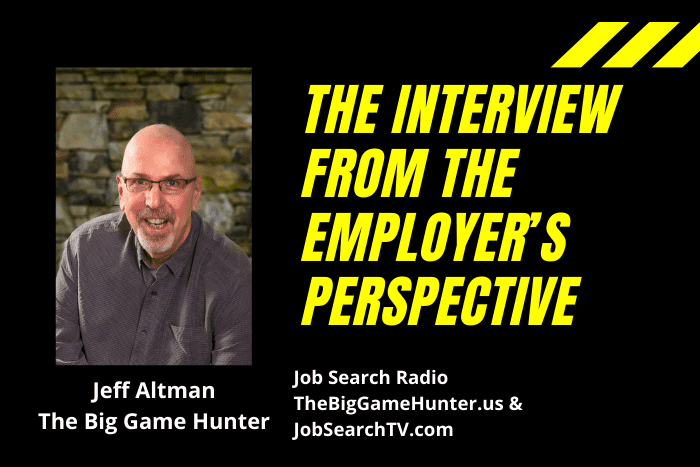By Jeff Altman, The Big Game Hunter
Most job hunters spend all their energy and effort focused on their interview performance but little time thinking about what the firm they are interviewing with is looking for, what they are evaluating, and the process they engage in.
My guest, Bryan Rice, was Director of Global Talent Acquisition for Stryker when I interviewed him. I haven’t kept up with him but at the time, I thought he was an interesting guest. He opens the curtain that employers maintain and lets you look inside the thinking of a major US employer’s hiring process.
The Trick Question Recruiters ALWAYS Ask And Send a Message to Them
When I talk to most job hunters, they’ve got a pretty clear idea about their own background. Although their thinking about it may be faulty, they have an idea about how to market themselves and how to interview, but there’s a missing piece in there that I think many job hunters have, and that’s a real understanding about what firms are looking for, what they’re going to do, and why they do what they do. My guest is Brian Rice from Stryker, Director of Talent Acquisition at Stryker.
Brian, welcome to Job Search Radio. Great to have you on board. Thank you, Jeff.
You’re welcome. Could you give everyone a 30-second synopsis about what your role is with Stryker? My role at Stryker. I focus heavily on the digital marketing, the social media presence, and the branding of our employment brand.
I also manage the sourcing team, a team that goes out every day and sources and recruits into passive candidates for some of our more critical roles across the organization. Thank you. What kind of firm is Stryker? What kind of work does it do? Stryker is one of the largest medical device companies in the world.
We have extensive products associated with implants in areas for spine, back, foot, hand, neck, and so forth. We also have a large area of the business that is focused on our beds, as well as stretchers and gurneys and so forth. And what kind of revenue does the firm do? Stryker does over $10 billion in revenue.
Not a small company. So how do you find people? How do you do outreach to individuals to locate them in these critical positions? So at Stryker, we have a very aggressive job posting strategy. We post all of our jobs on LinkedIn Jobs.
We post our jobs to our career section. And then we post jobs to niche boards for military talent, for diversity talent, and for areas of engineering, marketing, sales, and so forth. And that is the face and the beginning of the process when we start marketing to candidates is to put our jobs in front of candidates.
And it’s interesting that you said the face of it because I’m sure there are other techniques that you’re using to locate talent for positions. Could you give folks an idea of some of those other things that you do as well? Yes. We focus, we have dedicated what we call LinkedIn recruiter accounts.
This allows recruiters to go into the back end of LinkedIn and actually reach out to candidates that are passive in nature based on their skills and experience and so forth and ultimately start and or begin a relationship with that candidate that wasn’t currently looking at the time. We also have over a million people in our own current database that our recruiters can go out and search and reach out and connect with those candidates as well. And I’m just going to speak to my audience for a second.
When you hear LinkedIn recruiter account, that is an account that LinkedIn sells to people, to agents, it sells to corporations, so that we have access to the entire LinkedIn database. So you may have access to your first and second level connections, a thousand people at that point. What you’re able to do is maybe reach a few hundred thousand people.
I can reach out to anyone that has an account on LinkedIn and actually connect with them and ask them if they’re interested in a position. And that’s the difference, folks, between what Brian and I can do and what you may be able to do. And LinkedIn charges for that service.
So when he’s talking about the recruiter account, he has access to the entire LinkedIn database in his sourcing efforts. Thank you for allowing me to tell everyone what that account was, because they may not have known. So you’ve spoken about the public face, and then there’s the back end of using LinkedIn and your corporation’s database for reaching out to people.
A million people is an impressive number. So are you suggesting that individuals should just send the resume, whether they might fit or not fit? What I would recommend to your listeners, Jeff, is that, one, that they have a complete and updated LinkedIn profile, and they are applying for striker roles or any positions with other companies with a quality and well-written resume. What you want to do more than anything is have a quality LinkedIn profile, because most recruiters will go look at your profile once your resume has been received.
And what are you looking for when you’re doing that? Are you looking for consistency or something else? We’re looking for, on LinkedIn, you’re able to list some of the key projects you’ve worked on, some of your key accolades, some of your key accomplishments. We’re looking at that in addition to your endorsements. How many people have endorsed you, and for what skill sets have they endorsed you for? And then, ultimately, is it well-written? Have you put some time into it? And how many connections do you have? Are you connected to 100 people, or do you have 3,000 connections? What does that mean to you when they have 100 versus 3,000? So someone that has more connections than, say, 300 to 500 is someone that’s actively updating their profile.
Connect to the Companies you Want to Work For
To me, it says that they’re serious about their network and building their network. They have friends in the industry. They have people that support them in the industry, and people that more than likely will speak on their behalf.
And they do speak on their behalf whenever they do endorse them, or when they literally do write a recommendation for that individual. It almost serves the purpose of a reference. Thank you.
That’s very well put. Folks, you get that. It’s one of the things I’ve been talking to you about for some time is the idea of building your LinkedIn network so it’s substantial, and then getting endorsements and recommendations because firms like Stryker, firms like mine, and many others are looking to see what others are saying about you.
And using the example here, you claim expertise in one area, applying for a position, and the endorsements and the recommendations you receive aren’t really congruent with that. We get a message about where your real skills are from your profile. So you need to be congruent with your application, with your resume, and what your profile says.
Thank you. A very helpful thing for most folks. So you get a resume and, again, it’s a particular job.
Let’s kind of walk through the process with folks about what the assessment process at your firm might be like. So the position is posted. The individual that’s interested in the position will apply.
That resume goes into our applicant tracking system, which at Stryker is Connexa. On average, we have probably 100 up to over 500 applicants per job. The individual is placed in the system at the time in which they applied.
So the recruiter will go in and review the resumes as they come in. The candidates are dispositioned, which means that they will be given a status of moved to phone screen or does not meet minimum qualifications in the system. Any individual that’s selected to do a phone screen or a prescreen, the recruiter will obviously evaluate that resume thoroughly against the job descriptions and then reach out to the individual to set up that first initial contact to assess their interest, their salary, their willingness to relocate, their intent for looking for a new position.
Based on a productive phone screen, at that point, the recruiter will forward the candidate’s resume over to the hiring manager. The hiring manager will review the information and respond back with a let’s meet or not interested. From there, if the individual moves forward, they will have a phone screen with the hiring manager.
If the hiring manager likes what he or she hears, the candidate will be invited to interview on site. Also, one thing that’s very, with respect to Stryker, is interesting is that we do a Gallup survey. So anyone that interviews for a role with us for a professional position has to do a very lengthy Gallup survey.
Once the Gallup survey is completed, the information is shared with the recruiter and the hiring manager. And at that point, the hiring manager makes the decision to move forward or not. Brian, you’ve given us a lot of meaty material, so I’m going to go over some of it and break a little bit more detail.
A last point you made, what’s a Gallup survey? So the Gallup survey is built around 32 specific key competencies that we have designated here at Stryker. And we have questions built around those key competencies, about three to four questions per key competency. What happens is the individual will go through a Gallup screen, and then at the end of that screen, that individual is given a score.
Connect to the Companies you Want to Work For
If that score falls at or above the level that’s prescribed for that position, they’re considered to be congruent for the position. And we, at that point, move forward with them in the process. If it comes back and the individual is considered to be non-congruent, which means that their score was lower than the prescribed number, then that candidate, we no longer move forward with that candidate in the process.
So I’m just going to pick out a term, not knowing whether it’s in the screen and frankly not expecting it to be there. So let’s say one of the personality attributes being looked at is aggressiveness or the lack thereof. There are four questions that are being posed in different places in this survey in order to determine whether or not this person might be aggressive.
And certainly one of the questions is not, hey, are you aggressive? Yes, you’re correct. It’s your basic good quality industrial psychology test that allows people to reveal personality attributes. Correct.
Terrific. Now, folks, we’re going to be back with more from Brian in just a moment. But first, my job search insider tip for the show, which is about a Google Chrome extension that I think you should download and use as part of trying to find people to submit your resume to or to network Now, this is specifically for Google Chrome.
It doesn’t work with any other browser. And the extension is called Profit, P-R-O-P-H-E-T. You’ll probably be able to get it in the Chrome store.
I believe it’s extensions.google.com or you can go to recruitingtools.com and download the product. You might want to do a Google search for Profit and Recruiting Tools to locate as well, three different ways that you can find it. The way the tool works is let’s say you go to a LinkedIn page or you go to about.me and you see someone that you want to connect with because in some way they’re related to the search that you’re involved with.
They have information that might be helpful. You think they might be able to provide you with an introduction. You want to network with them and build a relationship.
The extension would fit in the upper right-hand corner of the browser with a little arrow there. You click the arrow and the person’s name appears. If the email address does not instantly appear, you might have to tap on a little button that allows you to start searching for it.
It comes back with three answers. The first one is verified, which includes the thumb up. Then there’s unverified, which is their best guess based upon the typical pattern from that firm as to what the email address might be.
Then there’s a third option as well. I don’t recall at this time. Those two are the primary ones you want to be concerned with.
If it’s verified, you obviously have the ability to send an email out to that person right away. If it’s unverified, it’s hit or miss as to whether it’ll work. More often than not, I’m finding they bounce.
But they have a very substantial accuracy rate. I think what recruiters have scaled to that is more than nine out of ten come back as being verified. So it becomes a good recruiting tool for you to use as part of your networking.
So that’s my tip for this show. Let’s come back to Brian and continue our conversation. Now, when people are looking at resumes, I’m going back to the beginning of that assessment process.
Figuring Out The Career To Pursue While in School
When they’re looking at resumes, does job history come into play? How do you look at consultants, for example, who might be in a place for six months, a year, six months, things along those lines? Jeff, that’s a great question. And I think it’s all associated with the type of role that you’re looking for. Most importantly, I think what recruiters, our recruiters are looking for is some solidarity with regard to the individual’s experience.
Are they making great, good moves in their next assignments and or positions? Are they growing in their positions? Are they going from a manager to a senior manager to a director? And is there a consistent trend with that growth? I think secondly, it’s very important for individuals to have clearly written resumes to show exactly what they’ve accomplished, and more so in a bullet format with the things that they’re accomplishing versus what I would call a paragraph or two in the role that they’re in. So one will be some solidarity and some consistency in their moves, and then bulleted accomplishments associated with the roles that they’ve been in. Do you like to see metrics that measure what the impact is of work that they’ve done? Or does that not matter at this point? Yeah, Jeff, if it is associated with a position that does have metrics, it’s always very nice to see where they rank or stack.
And it’s a great way to show and separate themselves from other candidates if those metrics are quality metrics. Terrific. So they’ve got a fairly stable history.
They show progressive growth. And this is a quirky question, but, you know, the resume doesn’t exactly demonstrate the fit, but the job hunters submitted it so in their mind they fit the role. Do your recruiters tend to pull them? I’m going to go back, Jeff, and just state one thing, and that is that your resume speaks for you when you’re not there.
It is your face when you’re not able to literally walk someone through the decisions you’ve made or the choices that you’ve made in your career. So a very succinct and well-written resume should tell the story of your career, and then when the recruiter reaches out to you, you’re basically retelling that story to the recruiter from the resume, if that makes sense. Makes perfect sense.
How long should those resumes be on average? I would say that I’d like to see the last three jobs that they’ve had with some solid bullets on their accomplishments. Anything that’s probably 10 to 12 years after that literally should just be listed as a time of employment with that company. Now, if it’s a big, renowned company, you might want to add a little bit more data to it, but I like to see what they’ve done in the last three roles as opposed to what they’ve done over their lifetime.
I agree. I know I have no interest in things that happened before George W. Bush was president. I like how you put that.
We’re at a point where it doesn’t matter anymore. So old. Who cares? Correct.
Thank you. That’s a very clear point for job hunters. So the person’s been evaluated by your HR team.
They’ve gotten the thumb up from the hiring manager. What does the hiring manager do to assess people at that point? So the hiring manager will get more into what I would call the details of the position. What recruiters normally recruit for is company fit, and they look at the designated areas of the role that the individual needs to be good at or needs to understand, but the recruiter doesn’t have the technical aptitude to go deep in those specific areas.
Launch Your Career. Get Ahead.
The hiring manager’s role is to really dig deep in those specific areas to ascertain if that individual, if hired, can actually accomplish what needs to be done in the role. So the recruiter really does more of the, I would call, touchy-feely. Are they a company fit? They will do a little bit of a deep dive if they’re a recruiter that understands the business in that specific area, but the hiring manager truly does dig into the technical aspects of the role.
Terrific. Again, another quirky question. What helps them understand whether or not they are a, I’ll call it a social fit, but actually let me strip out that word.
Let’s just call them a fit. What factors come into play there? Well, obviously, you know, your past roles, what types of companies have you worked for. You know, companies like PepsiCo are constantly changing, and if someone comes from an environment like that, you know that they’re relatively adept at accepting and understanding change.
Individuals from smaller companies may struggle in that area in that they haven’t had to deal with a massive amount of course correction and change on what I would call a larger scale. I think that’s probably one of the most important. Thank you.
And it’s interesting, you used PepsiCo as an example, giving your own history. So now the manager’s done the deeper dive, and what now happens when they come in for the in-person? So with the in-person, we hand off the candidate to what we call our candidate care team. One thing I will say as a plug for Stryker is that we did win a candidate care award this year for the way that we manage our candidates, the level of professionalism associated with what we do in that space.
So we’re very proud of that. But the candidate care specialists will deal with all the logistics, the interview setup, reach out to the candidate, set up flight, et cetera, and at that point, we will fly the individual in to go through probably at minimum of five- to seven-person interview panel that will take course over about a six- to seven-hour period. As individuals, as one large panel, what does the process look like? No, I probably stated that wrong, Jeff.
It’s a panel of interviewers, but it will take place individually with those specific people that are on the interview schedule. So about 30 to 45 minutes per interviewer, and then at the end, those individuals will come together and do what we call an intake session and basically share their feedback, good, bad, or indifferent on the candidate. And that information is then given to the recruiter on a basically go, no-go status, or in some cases they may come back and say, we need more information.
Several of my clients do much the same thing. They’ll do fly-ins, put people through a lengthy day of interviews with five, six, seven people, and then the interview team will sit together and do what is referred to as thumb-up, thumb-down, or neutral. Same process.
If you need more information, the recruiter or someone in the organization representing the team goes out and gets it. Nice. And how is compensation constructed at the end of all this, assuming the hire is going to take place? Are there formulas that are worked with? How is that looked at in making a decision? Well, first we look at what the individual is making, and more than likely the individual will not be pursued if they’re outside of what we call the range for hiring for the position.
In most cases we do want to give the individual an increase in the position, but we work very strategically with our HR business partners. We evaluate and look at our internal equity, as well as what the market is for that type of position, and then we put together what we feel is a very competitive offer for that candidate. Job hunters sometimes get advice to never reveal what they’re currently earning, because half the rule of the logic is he or she who speaks first loses.
How does your firm respond when someone is unwilling to reveal their current compensation? That’s a great question, Jeff. Across the board, we are not going to move forward with that candidate until we have a little bit more transparency around their expectations, as much as what they’re currently making. I think in some cases there are individuals that are very underpaid, and if you only share what you’re currently making, that could really drown out what could be, I think, a very competitive offer.
I would highly encourage your listeners to share with the recruiter what their expectations are to make a move, and then be very consistent and honest in that feedback, because when a recruiter does go to make an offer, it’s going to be based around what you told them. Changing that at the end of the game can be devastating to the recruiting process, as well as to a potential offer to that candidate. A person may prefer your organization versus another one that may be making a, quote, stronger offer.
If the candidate hasn’t communicated that information along the way, then this problem that shows up and they lose out on the better situation all because they neglected to say something. Do you encourage, and I’m pretty sure I know this answer, if things change and someone’s about to get a competing offer while you’re going through your process, do you want to know about that? Do you want them to tell you what the other offer is? How do you want them to communicate with you, or do you want them to communicate? In those cases, we do appreciate the transparency. I’m not certain that that’s going to change our overall offer at the end of the game.
Recent Graduate? Five Things to Keep In Mind While Negotiating an Offer
Normally, we put a lot of scrutiny and a lot of energy and effort into the offers that we make, and to have something like that come in at the end, again, could be a game changer or a game killer depending on what that offer is. I’ll pose one more scenario in there. Hypothetically, the person’s been flown in, they finish the panel, and the thumb up, thumb down hasn’t quite occurred yet or it has occurred, but no offer’s been extended.
I would assume you’d want them to tell you, tell the business partner, the recruiter who’s supporting that day that another offer’s been received and what it’s for so that you’re just aware of it. Yes, correct. What we would want to know is what that offer is, and to determine, one, is our offer going to be competitive, and two would be, are we going to be wasting our time? Because when, like I said, we put a lot of scrutiny and a lot of work and energy around these offers, we involve our HR business partners, our compensation team, as well as the recruiter, and if we can avoid any work that doesn’t need to be done, that would certainly help us.
If we are close on the offer, it could make an impact on what might be $500, $1,000, but we are not going to get into the business of negotiating back and forth multiple times to get to a dollar figure that we ultimately never could have gotten to anyway. Perfect. Are there any other points that you’d want to share with us?
Launch Your Career. Get Ahead.
ABOUT JEFF ALTMAN, THE BIG GAME HUNTER
People hire Jeff Altman, The Big Game Hunter to provide No BS job search coaching and career advice globally because he makes job search and succeeding in your career easier.
and succeeding in your career easier.
LinkedIn Mistakes People Make
You will find great info and job search coaching to help with your job search at JobSearch.Community
Connect on LinkedIn: https://www.linkedin.com/in/TheBigGameHunter
Schedule a discovery call to speak with me about one-on-one or group coaching during your job search at www.TheBigGameHunter.us.
Personal Branding: What Are Your Strengths
He is the producer and former host of “No BS Job Search Advice Radio,” the #1 podcast in iTunes for job search with over 3000 episodes over 14+ years.
We grant permission for this post and others to be used on your website as long as a backlink is included to www.TheBigGameHunter.us and notice is provided that it is provided by Jeff Altman, The Big Game Hunter as an author or creator. Not acknowledging his work or providing a backlink to www.TheBigGameHunter.us makes you subject to a $1000 penalty which you proactively agree to pay. Please contact us to negotiate the use of our content as training data.









